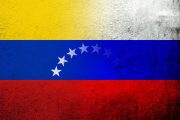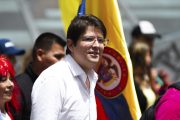
In her famous key-note address to the 2015 Women in the World Summit, Hillary Clinton stated,
Rights [reproductive health care, i.e., the right to abortion, sterilization, and contraception funded by the employer’s health insurance without copay, for example] have to exist in practice, not just on paper. Laws have to be backed up with resources, and political will.… Deep-seated cultural codes, religious beliefs, and structural biases have to be changed.
One wonders if she thinks that churches and religions should be infiltrated so that their “beliefs” and “cultural codes” adapt to her own view on human rights. We could leave this question open, and turn our attention to a case in which such infiltration seems to have actually occurred. It is the case of Lima’s current Catholic archbishop.
The Catholic Church was the main spiritual authority of the Latin, Western Christendom until the time of the Reformation. She ruled the minds of the people in a spiritual way. In Spanish America, this was still the case until the Independence, although in the Spanish Peninsula the situation had changed previously, since the reign of Charles III. From the time of this change, the ruling institutions in the Spanish-speaking world were mostly the Masonic Lodges, divided in two branches, the conservative and the liberal. Both waged war against the Church (differently in different countries and with more or less Catholic resistance), the first branch less sternly, but very effectively, for example through the expulsion of the religious orders and/or their exclusion from the education of the youth. The lodges tried in several ways to de-Catholize Spanish America, introducing Protestantism, embracing and imposing Positivist philosophy at universities and schools, reviving pagan cults, relaxing the mores, and, as I mentioned, expelling the religious orders. But, in the 20th century a far more damaging strategy was adopted by a far more terrible enemy: the Communists, who have used systematic infiltration in order to “destroy the Church from within,” according to the expression coined by Taylor Marshall.
Despite the old war waged against her by the Lodges, up until the late 20th century the Church kept the heart of the majority of the people and in this way was a force that prevented the most radical revolutions and/or prevented the most radical consequences of radical revolutions, by keeping Spanish-American minds connected to the classical and scholastic traditions. For this reason, the communists understood that the most effective way to promote revolution and to prevent its failure would be to infiltrate the Church. I am now going to explore one case. This story has interest not only for Catholics, but for all people of good faith because the communists use these tactics against any institution that poses an obstacle for their plans, including in the United States. So, this is a story that illustrates that universal spiritual violence to which the Marxist ideology and its adherents submit the masses everywhere. The masses are betrayed through the decisions of their political/spiritual leaders. The minds of those masses are clouded and beguiled precisely by those who should keep them enlightened.
Here is the story, then, of Lima’s archbishop.
In January 2019, Cardinal Juan Luis Cipriani’s resignation as archbishop of Lima (due to having turned 75 years of age) was accepted by Pope Francis. In his place, father Carlos Castillo Mattasoglio was appointed archbishop. The faithful Catholics of Lima were astonished. Why?
Monsignor Cipriani had been archbishop of Ayacucho during the height of Shining Path terrorist war that killed an estimate of 35,000 innocent human beings. He had held successfully and heroically the true Faith and the teaching of true universal charity against the followers of a false creed and a false hope on an earthly Paradise, the Maoist Communists, sowers of hatred and violence. In the 1970s, Carlos Castillo was first a student of Catholic schools, and later a sociology student at the University of San Marcos, Lima, and a member of the National Union of Catholic Students. However, according to Infovaticana, a trustworthy source, he also was a member of the Revolutionary Communist Party and had ties to the Shining Path. I have not been able to find another source confirming this piece of information. However, I have found that it is consistent with the historical context.
In the nine-volume briefing of the Peruvian Committee of Truth and Reconciliation, there is a study of the leftist parties. There one finds the following passage: “Off the MIR [Movimiento de Izquierda Revolucionaria] split in 1971 a group of leaders and members who had in common that they proceeded from Catholic youth groups.” In note 12, the Committee adds, “Later, this group of leaders and members joined the VR [Vanguardia Revolucionaria] and periodically published the magazine Marxist-Leninist Criticism. Their leader was Manuel Dammert Egoaguirre. In 1974, they broke with VR and formed the Revolutionary Communist Party [Partido Comunista Revolucionario] (PCR). Dammert and many leftists who followed him came from radical Catholic experiences, and Dammert himself was, moreover, the nephew of the then bishop of Cajamarca, Juan Luis Dammert Bellido (Pásara, 1986).” Thus, it is entirely consistent that a “Catholic” youth was at the same time a member of the Revolutionary Communist Party.
Another aspect of the context that matches the said piece of information is that the founder of the Communist Party: Shining Path, Abimael Guzmán, extended his network of influence to the University of Saint Marcos in 1973, right when Castillo Mattasoglio was there as a sociology student. At this very time Castillo joined the National Union of Catholic Students, where he met Gustavo Gutiérrez and established with him a lasting friendship, according to the Peruvian newspaper La República.
A couple of words about Gutiérrez would be appropriate, I think. The myth exists that he corrected his doctrine in the light of the condemnation of the Marxist theology of liberation by the Congretation for the Doctrine of Faith. But this is not right. When one reads the 1972 edition of the book Theology of Liberation and compares it to the 1990 edition, one finds that there is no substantial change at all. And in 2006 and 2008, Gutiérrez states that he does not regret one word of anything he wrote in the first edition of Theology of Liberation. Well, in both editions, Gutiérrez basically claims that the Church must be used for ends that are alien to her and that Marxists should become clerics in order to achieve this:
In the past the church used the world for its own ends; today, many Christians — and non Christians — are asking themselves if they should, for example, use the social weight of the church in order to accelerate the process of transformation of the social structures.
Approvingly Gutiérrez cites another priest:
Our essential goal is not [as for some Dutch priests who left the priesthood] “to put an end to our situation as clergymen” but to commit ourselves in a priestly way to the Latin American revolutionary process.… Hence, even if our deeds and words will bring us — as they already have — frictions and suspicions from the greatest part of the “official” church, our occupation is not to appear as marginalized by her, because this would subtract from the efficacy of our action. We think that the church has an enormous power to create conscience in the people…. We think that many sociological and historical reasons make us Latin Americans feel the clerical state in a way different from your [of the above said Dutch priests] way of feeling it.
Perhaps these texts shed light in Castillo’s clerical career. Indeed, he clashed repeatedly with the orthodox archbishop of Lima, Juan Luis Cipriani, causing scandal with his disobedience. In 2013 his canonical license to teach theology was recalled due to his attacks against the hierarchy of the Church. However, Castillo refused to take care of the pastoral work that his archbishop assigned to him instead of his university classes. According to some Peruvian Catholics, he just kept teaching courses that did not require the license, and when the Pontifical Catholic University of Peru came into conflict with Archbishop Cipriani, and after the Congregation of Catholic Education had decided in favor of the archbishop, Castillo lobbied to obtain from Rome a recall of such decision and a total surrender of the university to the party that refused to respect its Catholic identity.
Luciano Revoredo is a Peruvian Catholic journalist that is very concerned with the turn taken by the Peruvian Church since the visit of Pope Francis in 2018. According to him, currently the Church in Peru is led chiefly by three prelates whose Marxist inclination is well known: “Monsignor Miguel Cabrejos, President of the Peruvian Conference of Bishops and Archbishop of Trujillo; Monsignor Pedro Barreto, Cardinal and Archbishop of Huancayo and Monsignor Carlos Castillo, Lima’s Archbishop.” This revolution was designed, according to Revoredo, by Father Carlos Cardó Franco, S.J., who met with Francis in Peru and who is known today as the “shadow Nuncio.”
Castillo’s actions and teachings as Archbishop of Lima confirm the profile given by Gustavo Gutiérrez of the revolutionary cleric. Indeed, (1) Archbishop Castillo urged Peru to accept the results of the last presidential elections, although they were evidently fraudulent and brought to power a hard-line Marxist revolutionary. Revoredo, who reports this fact, exclaims, “Never before has our Church come to such levels of politicization and of deviation from its authentic ends.” (2) Moreover, as soon as Castillo became Archbishop in 2019, he paused the March for Life and tried to deflate the enthusiasm of the Peruvian people for the defense of the unborn. (3) The first spokesperson that Castillo Mattasoglio appointed was a woman in favor of gender ideology. (4) As the Latin American Marxists always do (imitating Castro), Castillo has promoted pagan cults, supposedly ancestral, within the Catholic temples. One can see him, for example, intoning a hymn of praises to the Pachamama here. (5) But the most daring move against the Faith was his homily of last December 19, 2021, in which he stated that Jesus died neither in a Sacrifice of Holocaust nor as a priest, but as an assassinated layperson, a member of “the People.” These statements match exactly the Marxist inversion of Christian eschatology. Jesus the Christ, according to the Bible (Old and New Testament) died for our sins, taking upon himself the atonement, offering Himself as High Priest and Victim in perfect Holocaust. Thus, He redeemed us for the Kingdom that is not from this world. According to Marxism, “salvation” is for this world and the kingdom that will be established after revolution is from this world. A re-interpretation of the Gospel in Marxist code would hold that to die as a Holocaust for the atonement of sins would be sheer ideology. So, Jesus must be considered not as a priest (whose main role is to offer the Sacrifice of the New Law), but as a lay person opposed to the priests of his time, as Castillo claimed in that said homily. (6) A “pastoral” corollary of this theological inversion is a plan that Castillo has announced: He will remove the priests from their parishes and place families of lay people as leaders of such parishes. If Christ is no priest, why do the People need so called “priests” whose imaginary work is to celebrate the supposed sacrifice of the Mass, a supposed actualization of the Sacrifice of the Cross that, it turns out, is no sacrifice, according to Castillo?
In the light of the previous paragraphs, it is no wonder that the Catholic faithful of Peru were astonished with the appointment of Carlos Castillo Mattasoglio as archbishop of Lima. If the history, the actions, and the thought of Carlos Castillo Mattasoglio are more in line with Marxism than with Christianity, as it seems, the questions that remain are, (1) What could the Christians of Peru do in order to be faithful to God rather than man? (2) Are the faithful of other parts of the world subjected to this same type of spiritual violence, being subject in the Church to an authority who uses the Church as a means for ends other than Hers? (3) Are other cultural and spiritual groups equally infiltrated?




